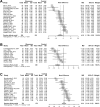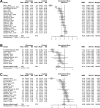Ocular Perfusion Pressure and the Risk of Open-Angle Glaucoma: Systematic Review and Meta-analysis
- PMID: 32572072
- PMCID: PMC7308312
- DOI: 10.1038/s41598-020-66914-w
Ocular Perfusion Pressure and the Risk of Open-Angle Glaucoma: Systematic Review and Meta-analysis
Abstract
Low ocular perfusion pressure (OPP) has been proposed as an important risk factor for glaucoma development and progression, but controversy still exists between studies. Therefore, we conducted a systematic review and meta-analysis to analyze the association between OPP and open-angle glaucoma (OAG). Studies were identified by searching PubMed and EMBASE databases. The pooled absolute and standardised mean difference in OPP between OAG patients and controls were evaluated using the random-effects model. Meta-regression analysis was conducted to investigate the factors associated with OPP difference between OAG patients and controls. A total of 43 studies were identified including 3,009 OAG patients, 369 patients with ocular hypertension, and 29,502 controls. The pooled absolute mean difference in OPP between OAG patients and controls was -2.52 mmHg (95% CI -4.06 to -0.98), meaning significantly lower OPP in OAG patients (P = 0.001). Subgroup analyses showed that OAG patients with baseline IOP > 21 mmHg (P = 0.019) and ocular hypertension patients also had significantly lower OPP than controls (P < 0.001), but such difference in OPP was not significant between OAG patients with baseline IOP of ≤21 mmHg and controls (P = 0.996). In conclusion, although no causal relationship was proven in the present study, our findings suggest that in patients with high baseline IOP, who already have a higher risk of glaucoma, low OPP might be another risk factor.
Conflict of interest statement
The authors declare no competing interests.
Figures





Similar articles
-
Ocular perfusion pressure and the incidence of glaucoma: real effect or artifact? The Rotterdam Study.Invest Ophthalmol Vis Sci. 2011 Aug 29;52(9):6875-81. doi: 10.1167/iovs.11-7376. Invest Ophthalmol Vis Sci. 2011. PMID: 21715354
-
Effect of hemodialysis on intraocular pressure and ocular perfusion pressure.JAMA Ophthalmol. 2013 Dec;131(12):1525-31. doi: 10.1001/jamaophthalmol.2013.5599. JAMA Ophthalmol. 2013. PMID: 24232671
-
Open-angle glaucoma and ocular hypertension: the Long Island Glaucoma Case-control Study.Ophthalmic Epidemiol. 1996 Jun;3(2):85-96. doi: 10.3109/09286589609080113. Ophthalmic Epidemiol. 1996. PMID: 8841060
-
[Open-angle glaucoma clinical presentation and management].Nippon Ganka Gakkai Zasshi. 2001 Dec;105(12):828-42. Nippon Ganka Gakkai Zasshi. 2001. PMID: 11802456 Review. Japanese.
-
Ocular perfusion pressure and glaucoma: clinical trial and epidemiologic findings.Curr Opin Ophthalmol. 2009 Mar;20(2):73-8. doi: 10.1097/ICU.0b013e32831eef82. Curr Opin Ophthalmol. 2009. PMID: 19240538 Free PMC article. Review.
Cited by
-
Differences and Similarities Between Primary Open Angle Glaucoma and Primary Angle-Closure Glaucoma.Eye Brain. 2024 Sep 17;16:39-54. doi: 10.2147/EB.S472920. eCollection 2024. Eye Brain. 2024. PMID: 39309574 Free PMC article. Review.
-
Progression of functional and structural glaucomatous damage in relation to diurnal and nocturnal dips in mean arterial pressure.Front Cardiovasc Med. 2022 Nov 15;9:1024044. doi: 10.3389/fcvm.2022.1024044. eCollection 2022. Front Cardiovasc Med. 2022. PMID: 36457809 Free PMC article.
-
Non-arteritic anterior ischemic optic neuropathy secondary to Posner-Schlossman syndrome in a twenty-six-year-old female.Am J Ophthalmol Case Rep. 2023 Feb 14;30:101816. doi: 10.1016/j.ajoc.2023.101816. eCollection 2023 Jun. Am J Ophthalmol Case Rep. 2023. PMID: 36865091 Free PMC article.
-
Ocular blood flow as it relates to race and disease on glaucoma.Adv Ophthalmol Optom. 2021 Aug;6:245-262. doi: 10.1016/j.yaoo.2021.04.016. Epub 2021 Jul 12. Adv Ophthalmol Optom. 2021. PMID: 35252630 Free PMC article.
-
Vascular Aspects in Glaucoma: From Pathogenesis to Therapeutic Approaches.Int J Mol Sci. 2021 Apr 28;22(9):4662. doi: 10.3390/ijms22094662. Int J Mol Sci. 2021. PMID: 33925045 Free PMC article. Review.
References
-
- Congdon NG, Friedman DS, Lietman T. Important causes of visual impairment in the world today. JAMA. 2003;290:2057–2060. - PubMed
-
- Jonas JB, et al. Glaucoma. Lancet. 2017;390:2183–2193. - PubMed
-
- Group C. Comparison of glaucomatous progression between untreated patients with normal-tension glaucoma and patients with therapeutically reduced intraocular pressures. Collaborative Normal-Tension Glaucoma Study Group. Am J Ophthalmol. 1998;126:487–497. - PubMed
-
- Kass, M. A. et al. The Ocular Hypertension Treatment Study: a randomized trial determines that topical ocular hypotensive medication delays or prevents the onset of primary open-angle glaucoma. Arch Ophthalmol 120, 701–713; discussion 829–730 (2002). - PubMed
-
- Leske MC, et al. Factors for glaucoma progression and the effect of treatment: the early manifest glaucoma trial. Arch Ophthalmol. 2003;121:48–56. - PubMed
Publication types
MeSH terms
LinkOut - more resources
Full Text Sources

